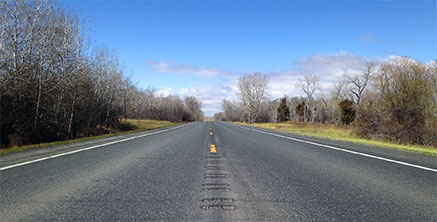Rumble Strips
What are Rumble Strips?

Rumble strips are grooves in the pavement that produce a rumbling noise and vibration when a vehicle drives over the strip. Shoulder rumble strips have been utilized on Montana's highways for decades to alert drivers veering off the side of the road. Rumble strips, installed along the centerline of two-way highways, are the newest addition to Montana's rumble strip safety implementation. Centerline rumble strips are a key measure in Montana Department of Transportation's Vision Zero initiative to reach zero deaths and zero serious injuries on Montana's roads.
MDT conducted a five-year statewide installation of centerline rumble strips designed to prevent roadway departure crashes, particularly head-on and sideswipe crashes that occur when a vehicle crosses the centerline of a two-lane highway into the oncoming lane of traffic.
Benefits of Rumble Strips
- Provide immediate / direct feedback to drivers or motorcyclists unintentionally crossing the centerline or shoulder of two-lane highways, giving distracted or drowsy drivers time to correct course.
- Act as a guideline to vehicles and snowplows in winter whiteout conditions and other low-visibility conditions.
- Effective in lowering the number of highway fatalities and serious injuries in other states where implemented. For instance, centerline rumble strips reduce total roadway departure crashes as much as 42 percent and fatal and severe injury crashes as much as 73 percent.
- Are a low-cost safety measure. Compared to $1 million per mile of total highway reconstruction cost, rumble strips cost about $5,000 per mile to install.
Driving with Centerline Rumble Strips
Montana drivers should be aware of the following when driving on two-lane highways installed with centerline rumble strips:
- Passing is allowed in passing zones. Centerline rumble strips are installed in both passing and non-passing zones. They are not meant to deter safe passing by car, truck or motorcycle.
- Don't hug the shoulder. This makes bicyclists nervous. Be sure to give bicyclists plenty of shoulder room.
- Centerline rumble strips may seem louder when you drive over them compared to shoulder strips. This is because the vehicle and driver's body is right over the strip.
Rumble Strips and Motorcyclists and Bicyclists
MDT is dedicated to making the state's roadways safe for all those that use them for transportation and recreation. As with cars and trucks, rumble strips are effective in keeping motorcyclists alert and in their lanes.
In MDT's design of rumble strip installations, they have consulted with bicycle advocate groups, such as Bike Walk Montana, to design a rumble strip width that leaves plenty of space for bicyclists. The width of the centerline rumble strip is modified based on the size of the road's shoulder. Rumble strips are six inches wide on a highway with no shoulder, eight inches wide on highways with a two-foot shoulder, and 12 inches wide with a four-foot or wider shoulder. A modified shoulder rumble strip is also installed on bicyclist-designated highways / routes that have a shoulder width of less than four feet. To accommodate bicyclists as well, shoulder rumble strips have a 13-foot gap every 47 feet.
Montana's Centerline Rumble Strip Implementation
MDT is targeting specific stretches of highway for the centerline rumble strip implementation. Installation occurred on two-lane highways that meet these criteria:
- Have been the site of at least one fatal or serious injury roadway departure crash in 10 miles over a five-year period. In particular, MDT is prioritizing highways that have been sites of these types of roadway departure crashes: head-on, side-swipe from the opposite direction and left-side off-the-road crashes.
- The posted speed limit is above 45 mph.
- Rural areas, outside more densely populated suburban areas where rumble strip noise could be an annoyance.
Frequently Asked Questions
When were rumble strip policies invoked? Who set out the rumble strip policy?
The current rumble strip policy was established in 2015 by MDT’s Chief Engineer in response to nationwide research indicating that the number of roadway departure crashes significantly decreased using rumble strips. Roadway departure crashes (run-off-the-road, head-on, and opposite direction sideswipe crashes) are documented as the highest percentage of crash type for Montana’s highways, so installing rumble strips can help significantly reduce fatal and serious injury crashes on Montana highways.
Where is the funding coming from for rumble strips?
Funding for the installation of rumble strips comes from several federally funded programs, depending on the highway project in question. The recent statewide initiative to install centerline rumble strips (CLRS) was funded by Highway Safety Improvement Program (HSIP) funds since CLRS are recognized as a nationally proven safety countermeasure [safety.fhwa.dot.gov]. MDT analyzed routes with a history of roadway departure crashes to select routes as discussed above.
Were any Montana citizens (farmers, ranchers, and people who live beside highways) given a chance to provide input on the rumble strips?
Yes, Montana citizens have and will continue to be encouraged to give feedback per MCA 60-2-245. MDT is committed to engaging and informing the public through our website, newspaper, tv, and radio, as well as electronic and social media. View an example here charkoosta.com.
Centerline Rumble Strip Installation Schedule:
Contact
Gabe Priebe, PE,
Traffic & Safety Engineer
406-444-9252 | Email
